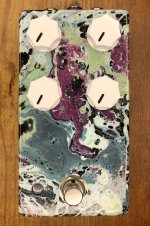Aleph Null
Well-known member
Clever Hans is the big brother of the One Chip Pony. It's based on the same comparator engine, but the added EQ options make it much more versatile—truly a horse of a different color!

For simple or standardized control layouts, I like hydrodip finishes. This one is seaside, ocean mist, pistachio, and grape over a black powder coat.

I'm loving ribbon cables lately. The board is designed to keep off-board wiring as minimal and clean as possible.

The input stage is a mosfet boost with a heavy low-pass filter. This filter helps minimize string noise when the Gate is set high. This stage feeds the comparator. The comparator doesn't distort like most fuzzes. Instead of amplifying the signal until it clips, the signal is compared to the bias voltage. If the input is lower, the outup shoots up to the upper rail. If the input is higher, the output is slammed to ground. It's maximum fuzz and maximum compression all the time! The comparator then hits the EQ section. Contour is a simple input capacitor blend, but it's very effective. The Filter control is a multi-feedback low pass filter. This is actually similar to the filtering that a lot of PT2399 delay circuits use. This filter creates a resonant peak at the cut-off frequency of roughly 3–6dB. That peak keeps the signal from getting muddy, even with heavy treble attenuation.
The result is a powerful fuzz—with essentially no noise floor—that you can EQ to sit just right in a mix.
Here's a demo:
As always, I have extra PCBs. If you're interested, just DM me!

For simple or standardized control layouts, I like hydrodip finishes. This one is seaside, ocean mist, pistachio, and grape over a black powder coat.

I'm loving ribbon cables lately. The board is designed to keep off-board wiring as minimal and clean as possible.

The input stage is a mosfet boost with a heavy low-pass filter. This filter helps minimize string noise when the Gate is set high. This stage feeds the comparator. The comparator doesn't distort like most fuzzes. Instead of amplifying the signal until it clips, the signal is compared to the bias voltage. If the input is lower, the outup shoots up to the upper rail. If the input is higher, the output is slammed to ground. It's maximum fuzz and maximum compression all the time! The comparator then hits the EQ section. Contour is a simple input capacitor blend, but it's very effective. The Filter control is a multi-feedback low pass filter. This is actually similar to the filtering that a lot of PT2399 delay circuits use. This filter creates a resonant peak at the cut-off frequency of roughly 3–6dB. That peak keeps the signal from getting muddy, even with heavy treble attenuation.
The result is a powerful fuzz—with essentially no noise floor—that you can EQ to sit just right in a mix.
Here's a demo:
As always, I have extra PCBs. If you're interested, just DM me!
Attachments
Last edited:


